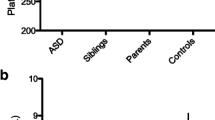Abstract
Whole blood serotonin levels and platelet counts were studied in 14 families, representing 57 family members and 15 probands who met DSM III criteria for infantile autism. High serotonin appeared to segregate in families. When two parents had high serotonin, the serotonin level in their offspring was twice the parental level. When one parent had high serotonin, the serotonin level in the offspring approximated the level of serotonin in either the high serotonin parent or the low serotonin parent. For the case where both parents had low serotonin, in one family the children had low serotonin and in a second family, high serotonin levels were present in the autistic proband, and a sibling with severe mental retardation. Mean serotonin levels were higher for both male and female, autistics and family members, in the four black families than in the 10 Caucasian families.
Similar content being viewed by others
References
Abramson, R. K., Wright, H. H., Brennan, W., Lumpuy, O., & Genco, P. (1986). Autism, familial hyperserotoninemia and HLA.American Journal of Human Genetics, 39, A49.
American Psychiatric Association. (1980).Diagnostic and statistical manual of mental disorders (3rd ed.). Washington, DC: Author.
Anderson, G. M., & Hoshino, Y. (1987). Neurochemical studies of autism. In D. J. Cohen & A. M. Donnellan (Eds.),Handbook of autism and developmental disorders (pp. 166). Silver Spring, MD: Winston.
Blomquist, H. K., Bohman, M., Evensson, S. O., Gilberg, C., Gustavson, K. H., Holmgren, G., & Wahlstrom, J. (1985). Frequency of the Fragile X Syndrome in infantile autism. A Swedish multicenter study.Clinical Genetics, 37, 113–117.
Campbell, M., Friedman, E., DeVito, E., Greenspan, L., & Collins, P. J. (1974). Blood serotonin in psychotic and brain damaged children.Journal of Autism and Childhood Schizophrenia, 4, 33–41.
Campbell, M., Friedman, E., Green, W. H., Collins, P. J., Small, A. M., & Breuer, H. (1975). Blood serotonin in schizophrenic children.International Journal of Pharmacopsychiatry, 10, 213–221.
Goldfine, P. E., McPherson, P. M., Health, G. A., Hardesty, V. A., Beauregard, L. J., & Gordon, B. (1985). Association of Fragile X Syndrome with autism.American Journal Psychiatry, 142, 108.
Fisch, G. S., Cohen, I. L., Wolf, E. G., Brown, W. T., Jenkins, E. C., & Gross, A. (1986). Autism and the Fragile X Syndrome.American Journal of Psychiatry, 143, 71.
Hanley, H. G., Stahl, S. M., & Freedman, D. X. (1977). Hyperserotonemiia and amine metabolites in autistic and retarded children.Archives of General Psychiatry, 34, 521–531.
Hoshino, Y., Kumashiro, & Kaneko, M. (1979). Serum serotonin, free tryptophan, plasmic cyclic AMP levels in autistic children.Fukushima Journal of Medical Science, 16, 79.
Hoshino, Y., Yamamoto, T., Kaneko, M., Tachibana, R., Watanabe, M., Ono, Y., and Kumashior, H. (1984). Blood serotonin and free tryptophan concentration in autistic children.Neuropsychobiology, 11, 22–27.
Kanner, L. (1943). Autistic disturbances of affective contact.Neuvous Child, 2, 217.
Kuperman, S., Beeghly, J. H. L., Burns, T., & Tsai, L. Y. (1985) Serotonin relationships of autistic probands and their first degree relatives.Journal of the American Academy of Child Psychiatry, 24, 186–190.
Kuperman, S., Beeghly, J., Burns, T., & Tsai, L. (1987). Association of serotonin concentration to behavior and IQ in autistic children.Journal of Autism and Developmental Disorders, 17, 133–140.
Ritvo, E. R., Yuwiler, A., Geller, E., Ornitz, E. M., Saeger, K., & Plotkin, S. (1970). Increased blood serotonin and platelets in early infantile autism.Archives of General Psychiatry, 23, 566–572.
Rutter, M., & Hersvo, L. (Eds.). (1976).Child Psychiatry: Modern Approaches. Oxford, England: Blackwell.
Schain, R. J., & Freedman, D. X. (1961). Studies on 5-hydroxyindole metabolism in autistic and other mentally retarded children.Journal of Pediatrics, 58, 315–320.
Takahashi, S., Kanai, H., & Miyamoto, Y. (1976). Reassessment of elevated serotonin levels in blood platelets in early infantile autism.Journal of Autism and Childhood Schizophrenia, 6, 317–326.
Wright, H. H., Young, S. R., Edwards, J. G., Abramson, R. K., & Duncan, J. (1986). Fragile X Syndrome in a population of autistic children.Journal of the American Academy of Child Psychiatry, 25, 641–644.
Yuwiler, A., Plotkin, S., Geller, E., & Ritvo, E. (1970). A rapid accurate procedure for the determination of serotonin in whole blood.Biochemical Medicine, 3, 426–436.
Yuwiler, A., Ritvo, E. R., Bald, D., Kipper, D., & Koper, A. (1971). Examination of circadian rhythmicity of blood serotonin and platelets in autistic and non-autistic children.Journal of Autism, and Childhood Schizophrenia, 1, 421–435.
Author information
Authors and Affiliations
Additional information
The research was supported in part by NIH-BRSG 2507-RR-0585-01, the March of Dimes 8-85-49, 8-85-08, and the Health Resources Foundation.
Rights and permissions
About this article
Cite this article
Abramson, R.K., Wright, H.H., Carpenter, R. et al. Elevated blood serotonin in autistic probands and their first-degree relatives. J Autism Dev Disord 19, 397–407 (1989). https://doi.org/10.1007/BF02212938
Issue Date:
DOI: https://doi.org/10.1007/BF02212938




